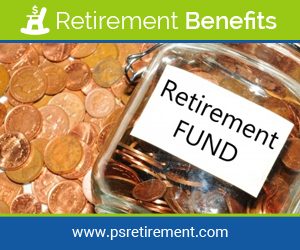retirement benefits
Retirement benefits are the monetary and other benefits and incentives provided to the retired officers and employees of the government.
Do You Actually Understand Thrift Saving Plan (TSP) Investments? By: Aaron Steele
/by aaron steeleHow well do you understand the TSP fund options? Here’s a quick rundown.
As the world’s largest employer-sponsored savings plan, the Thrift Savings Plan (TSP) plays a role in the retirement plans of every FERS federal employee.
Every year, many people become millionaires simply by making good use of their TSP account.
However, without at least a basic understanding of the TSP funds, it’s extremely difficult to be successful in the TSP over the long term.
This article will quickly bring you up to speed on the essentials of the TSP fund options.
The Fundamentals
The TSP offers only five core fund options. Here they are, along with a brief description of what they invest in:
-
- G Fund: Investments in U.S. Treasury Bonds.
- F Fund: Investments in several types of U.S.-based bonds.
- C Fund: Investments in 500 of some of the biggest U.S. companies (Follows the S&P 500).
- S Fund: Investments in most other major U.S. companies (aside from the S&P 500).
- I Fund: Investments in the major companies in Europe, Australasia, and the Far East.
Note: There’re also L Funds in the TSP, but these are simply a mix of the core five funds.
The Conservative TSP Funds
The G and F Funds are the most conservative of the five funds because they are less volatile than the others. However, as a trade-off for being more stable, they lack the potential to grow as much as the other funds.
Although the G Fund guarantees that any money invested in it won’t lose value, it has only averaged about a 2% annual return over the last ten years.
The F Fund’s value can fall, but it remains very stable compared to the other funds. Over the last ten years, it has averaged a 3.6% annual return.
The Issue with the G and F Funds
As they near retirement, many people will invest the majority of their TSP assets in a combination of the G and F Funds. While investing a part of your money in conservative funds might be a wise decision, many individuals overdo it.
The G and F Funds are unlikely to lose value, but they’re also unlikely to grow much. This lack of significant growth, as well as inflation, can have a substantial impact on your money over time.
For example, if the prices of goods and services rise every year (inflation) and your investments don’t increase quickly enough to compensate, you may deplete your TSP far faster than you had planned.
This does not suggest that the G and F Funds are bad investments. They are excellent funds that do exactly what they’re supposed to do. However, you’ll want to ensure that you also have investments to help you maintain your usual lifestyle during retirement.
The Aggressive TSP Funds
The C, S, and I Funds are the aggressive TSP funds.
They are dubbed “aggressive” because they have a far higher probability of sustaining significant growth over time. However, as a result, they can be significantly more volatile than the G and F Funds.
For instance, the C Fund lost more than 35% in 2008 but recovered it all and more in the next several years.
It is advised you not put any money into these funds that you’ll require in the coming years. These funds will perform better in the long run but are less predictable in the short term.
The L Funds
The most crucial thing to remember about the L Funds is that they’re not independent funds. They’re essentially various combinations of the main five funds that we have discussed.
What distinguishes them is that each L Fund is designed to gradually grow more conservative over time. In principle, one might invest in a single L Fund and never have to modify their investment allocation for the remainder of their career.
Final Thoughts
We hope you have a better knowledge of the various TSP funds and what they’re meant to accomplish. Now, you’ll be much more prepared to understand when you read about investing strategies.
Congressional Watchdog Finds That Almost 40% of Participants Don’t Understand 401(k) Fees. By: Joe Carreno
/by joe carrenoOn Thursday, August 26, 2021, the Government Accountability Office (GAO), a congressional watchdog, released a report stating that almost 40% of 401(k) participants do not fully understand the scheme’s fees. For the past ten years, the US Department of Labor has requested sponsors to educate participants about the fees associated with their accounts. Yet, a significant number of participants do not completely understand the fees.
Democrat lawmakers, Sen. Patty Murray of Washington and Rep. Bobby Scott of Virginia had requested the report. Sen. Murray chairs the US Senate Health, Education, Labor, and Pensions Committee, while Rep. Scott chairs the House Committee on Education and Labor.
Scott said the findings of GAO should serve as a wake-up call for the Labor Department and 401(k) participants. He added that the report indicates that the Labor Department must make it compulsory for plan sponsors to give participants full fee disclosures. He added that the disclosures should be easy to understand and that participants should know how the fees affect their contributions.
The report stated that about 87 million employees have 401(k) plans, making the accounts one of the most popular ways people save for retirement. Around 71% of workers in the private sector, and local and state governments received their retirement benefits in March 2020. Of this percentage, 55% had 401(k) accounts.
401(k) participants must understand the effects of administrative and investing fees on their contributions as participants who do not understand them may be adversely affected.
Murray described retirement savings as long-term investments. As such, the Democrat said participants need “clear, complete information.” He added that the report shows that 401(k) participants do not have the needed information to make informed choices about their long-term retirement investments.
What Participants Do Not Understand about 401(k) Fees
For its findings, GAO surveyed 1,000 401(k) participants. The survey included questions that were meant to test participants’ knowledge of the fees. The government watchdog found that many respondents know about the existence of the fees, but they do not completely understand how the fees affect them. Other respondents do not know about the existence of the fees at all. The members of the latter category made up about 64% of respondents. These respondents didn’t know if they were paying any fees or even if the fees even existed.
65% of the participants didn’t know how much additional fees they paid on the 401(k) accounts. The government watchdog found that females and savers with less than $1,000 made up a majority of this group. It also discovered that education was a factor. More people with high school diplomas or less also said they do not understand the fees.
“Americans are already struggling to stretch their paychecks and save for retirement,” Chairman Scott stated. “Making fee disclosures more accessible is a common-sense change that will help more people retire with dignity.”
Long-Term Effects on Participants
Employer-sponsored 401(k) plans and any other investment account come with costs. Participants and their employers pay the fees. Some they pay independently and some together. However, participants have to be aware of these fees, or their savings could be adversely affected. In 2006, GAO submitted a report that shows how an increase of 1% could reduce retirement savings by tens of thousands of dollars.
For example, a worker who contributes $20,000 to a 401(k) plan with a 7% return rate and 0.5% fee will have $70,500 after 20 years. If the fee is increased to 1.5%, the worker will have $58,000 at retirement. The 1% fee increase caused a 17% reduction in the worker’s earnings.
GAO Recommendations
GAO made five recommendations to the Labor Department. These recommendations will enhance contributors’ knowledge of the long-term effects of the fees. The recommendations are:
- – The department should enforce the use of a consistent term for asset-based investment fees.
- – It should stipulate the fees in quarterly disclosures.
- – It should educate participants on the long-term effects of the fees.
- – It should add fee benchmarks for in-plan investment options.
- – It should add ticker information for investment options in disclosures.
The department has responded to the committee’s recommendations. It stated that it is unable to enforce the recommendations at the moment but would consider adopting them in the future. The committee, in turn, urged the department to do whatever it can to help the Americans who are saving money.
Americans with a DC Plan more Optimistic about Retirement Savings
/by AdminA new survey has revealed that the Americans who have a DC plan are more optimistic about their retirement savings. The satisfaction was mapped against the data collected in 2012. People were also more optimistic about not having to work past retirement and their savings lasting for the lifetime. The survey highlighted that some DC Plan participants were less confident about retirement. It also pointed out that many people were aware that they need to start saving more towards retirement. Many of them also admitted that they have not succeeded in achieving their retirement savings goals last year.
Auto Enrolling for Retirement Savings
A new survey conducted by Mathew Greenwald & Associates in conjunction with J.P. Morgan Asset Management has revealed that Millennials are preferring auto-enrolment and auto-escalation methods to boost their retirement savings. The survey was aimed at knowing how the DC plan participants’ opinion on retirement readiness has changed since 2012.
The Result
The survey found out that the outlook on the matter of retirement savings has somewhat improved since 2012. The survey was conducted in January 2016 and the subjects of the survey were 1,001 plan participants. The survey was conducted online. It revealed that about 59 percent participants think that they would need to work past retirement. This percentage was 70 percent in 2012. The survey also discovered that about 44 percent people are confident that their savings would last throughout retirement. This percentage was earlier just 31 percent.
The Fears
The survey has also found out that over half of the DC participants, 56 percent to be precise, believe that the retirement savings they have may not last the entire lifetime. In the survey, about 68 percent participants admitted that their contribution rates in 2015 were lower than they expected or what it should have been. The same group of people believed that they must save at least 20 percent more than what they are saving right now if they wish to have a better retirement.
Nearly 75 percent of these participants also shared that they must save about 10 percent more of their pretax salary to boost their retirement savings. About 76 percent of people have confessed that they missed this vital target last year. The reasons that are stopping these people from saving more are inertia and increasing financial demands of today’s times.
Nearly Half of Young Americans have Zero Retirement Benefits Savings
/by AdminThe retirement savings of young Americans are not up to the mark. It has been proven again by a survey which found out that nearly half of young Americans have zero retirement benefits savings. Their chances of getting regular income post-retirement are also low and they also don’t trust the social security system. Still, the majority of young Americans believe that they will have ample amount of money in retirement.

Survey Exposing Zero Retirement Benefits Savings
The survey that revealed the retirement savings problem was conducted by the Black Youth Project at the University of Chicago in association with Associated Press-NORC Center for Public Affairs Research. The survey was conducted via a GenForward poll. It stated that 48 percent of Americans who were between the ages of 18 to 30 have zero retirement benefits savings and they don’t have access to a traditional pension either. Over 4 in 10 respondents between the ages of 25 to 30 have admitted that they have saved nothing for retirement.
Fewer Traditional Pensions
In the survey, it was also revealed that younger Americans won’t be able to access the traditional pensions that were enjoyed by earlier generations. Only 7 percent of the respondents said that they would be getting the rare benefit so that they get a pre-defined monthly amount post retirement.
No Faith in Social Security
The age in which the Americans receive social security is climbing high too. It is up to 67 rather than 66 so young Americans would have to wait longer for it as compared to their parents and grandparents. Young Americans don’t have faith in the social security system. Only 5 percent have admitted to having full confidence in this benefit while 28 percent said that they are somewhat confident.
The Self Confidence
Despite the sad fact that many of the young Americans have zero retirement benefits savings, their confidence in their own abilities is not lacking. A majority of the respondents admitted that they would have enough money they need in retirement and they will not be dependent on others. About 53 to 56 percent of Asian Americans, African Americans, and white Americans are sure that they will have enough money post-retirement. Only the confidence level of the Latinos is not that high. Just 43 percent think that they are either very confident or somewhat confident that they would have enough money to live comfortably in retirement.
The Bad News Regarding Retirement Benefits of Baby Boomers
/by Matt PierceWe recently reported how Baby Boomers are meeting the retirement challenges nicely. Unfortunately, all is not as good as it seems. There are some negative findings in the 17th Annual Transamerica Retirement Survey of Workers. These findings state that baby boomers might not be able to work for as long as they wish. It also highlights that baby boomers have low savings, menial backup plans and minimal knowledge of social security.

Why Baby Boomers Won’t Increase their Retirement Benefits by Working Longer?
Many baby boomers expected to increase their retirement benefits savings by working for a few years after retirement but this may not be possible. The reasons may vary from declining health to lack of job opportunities, says the 2016 Retirement Confidence Survey.
Employers are not Aging Friendly
About 47 percent baby boomers accepted in the TCRS survey that their employers may allow them to work past retirement as they are aging-friendly. The rest of them think that they might not be able to keep the job post retirement. About 29 percent admitted that their employers have made flexible transition arrangements.
Savings Difficulty
About 42 percent baby boomers said that their retirement savings are not enough or too low. The median amount they think they need is about $500,000. But when the 4 percent rule is used as a reality check, the annual income would be just $20,000 per year which is not enough to cover the expenses even when the social security income is added to it.
Lack of Financial Counseling and SS Knowledge
It is believed that financial counseling might help in increasing the savings but only 12 percent baby boomers admit that their employers provide any finance related counseling. About 19 percent of baby boomers accepted that they know a great deal about social security and 34 percent expected social security to be the primary source of income post retirement.
Minimal Backup
Only 25 percent of baby boomers have a backup plan in place if they are unable to work until they plan. About 26 percent said that they have only less than $5,000 to take care of a financial setback such as a medical emergency, unemployment, etc. Lack of a backup plan means that more than 28 percent have taken a loan, opted for early distribution or made a hardship withdrawal from IRA or their retirement benefits savings.
Another Report Proves that Many Americans Have No Retirement Benefits Savings
/by AdminSome Americans have got a nice nest egg for retirement but many of them have no retirement plan or retirement benefits savings. This was proven by a report revealed by the EPI. It stated that super savers are pulling the average savings of American families while some Americans have zero savings. The report also proved that people who are in the later stages of life are better savers.
 The Sad Fact Regarding Retirement Benefits Savings
The Sad Fact Regarding Retirement Benefits Savings
The report presented by the Economic Policy Institute states that nearly half of the families in America have no retirement benefits savings at all. It also states that the mean retirement savings of all families come to about $95,776. But this number does not tell the whole story as many families have zero savings and super savers are pulling the average up. The report states that having a look at the median savings or those at 5th percentile is a better gauge. The median for all U.S. families is just $5000 and the median for families who have some savings comes down to $60,000.
A Huge Gap
There is a huge gap between the mean and median retirement savings that are $95,776 and $5000 respectively clearly indicated inequality. It shows that the large account balances of the families that have the most savings are driving the average for all families up. This inequality was pointed out by the researchers of the report.
Another Shocker
The report also highlights the fact that the gap between the rich people and the poor ones is increasing constantly. The rich are getting richer and the poor are getting poorer. The participation in retirement plans is also unequal. About 9 out of 10 families of the rich had a retirement savings account in 2013 and the number of families who were poor barely had one account out of every 10 counted in the report.
Retirement Savings and Age Factor
The EPI report also showed that the retirement benefits inequality is influencing the median savings too. The median savings broken down by age is very different. The average savings made by a family with members between 32 and 37 is $31,644 while their median savings is less than $500. In contrast, the average savings of families that have people close to retirement or between the ages of 56 to 61 is about $163,557. Their median comes down to $17,000.
Retirement Benefits Savings are Increasing But Not Fast Enough
/by AdminThe issue of retirement benefits savings has become a hot topic in the recent times. Everyone is worried about whether they are saving enough or how will they live a comfortable life post retirement. People who worry about it must be pleased to know that Americans are doing good in preparing for retirement, but there is still a lot of room for improvement. A new survey has revealed the saving pattern of various generations and has pointed out how many people have less than $100,000 saved for retirement.
 The Survey Showing Retirement Benefits Savings Pattern
The Survey Showing Retirement Benefits Savings Pattern
The survey that tries to highlight how Americans retirement benefits savings have increased was conducted by Fidelity Investments. It is an American company that helps people to prepare for retirement by offering various options such as ETFs, IRAs, etc. The results of the survey were put in a report known as Retirement Preparedness Measure. It is a part of the company’s bi-annual retirement savings assessment. The key finding in the report was that people are getting closer to their retirement goals by saving more with time.
The Major Problem
The report also showed a major problem with regard to the retirement savings. It showed that about 55 percent of people are still at the risk of being unable to completely cover the vital living expenses post retirement. The vital living expenses include paying for basic things like health care, housing and food.
The Key Results
Other key things that were highlighted in the report and are worth knowing are listed as follows:
- A full third of Americans have no retirement savings at all.
- About three in four Americans have less than $1, 00,000 saved towards retirement.
- Americans who are older than 55 years of age were also analyzed. About 60 percent of them have less money saved than the $1, 00,000 mark. Around 28 percent people at this age have no savings at all.
- The saving habits of the GenXers were also studied and it was discovered that 72 percent of them have less than $1, 00,000 saved towards retirement. About 30 percent of GenXers have no savings at all.
- The saving patterns of the Millennials were also analyzed. It showed that 90 percent of Millennials have saved less than $1, 00,000 towards the retirement benefits. About 42 percent of Millennials have no savings at all.
The Retirement Benefits Savings Gap is Increasing
/by AdminIt is a fact that rich people always have more money to spare for their retirement benefits savings as compared to an average income person. This fact was reiterated recently by a report which shows that the savings gap due to different incomes is rising. The rich are growing richer and the poor are growing poorer as per the report. The report calculated the exact amount of money saved by the families of different earning groups. It studied the savings done by various families during the time span of 1989 to 2013.
 How the Retirement Benefits Savings Gap is Increasing?
How the Retirement Benefits Savings Gap is Increasing?
The report which stated that the retirement benefits savings gap is increasing was compiled by the Economic Policy Institute, known as the EPI at times. The crux of the report is that the rich are growing richer and the poor are growing poorer. This is the phrase that perfectly applies to the current state of the American retirement.
The Inequality
The report also pointed out that the participation of people is quite unequal across varied income groups. In the year 2013, about 9 in 10 families in the top income fifth had some retirement benefits savings as compared to less than one family that has retirement savings and was a part of the lower income fifth.
Gap Between Haves and Have-Nots
The median working age family just had only $5,000 saved in the year 2013 while the amount saved by an 80 percentile family was about $116,000. The 90 percentile family had even more savings at $274,000. The 60 percentile families had $20,100 stashed towards retirement in 2013 while the 70 percentile families had more than $50,000 stashed for the same purpose. The top 1 percent of families are doing better than everyone. They had more than $1,080,000 kept away towards their retirement benefits savings as per the EPI report.
The Disclosure
The disclosure of the retirement benefits savings of families within the age of 32-61 was done by savings percentile by EPI. It also studied how the retirement saving capabilities of various income group families have changed in the last few decades. The sample period taken for the study was from 1989 to 2013. During this period, the savings done by the poor families have not increased by much but the savings done by the richest families have grown exponentially.
Oregon has a Clear Path for State Retirement Benefits Plan
/by AdminThe state of Oregon can now easily help the private sector employees to get access to a state-run retirement benefits plan. This plan was earlier facing a key federal hurdle that has cleared now. This plan would be implemented in stages and ensure that all the workers of Oregon who have no access to a plan from their employer could have some retirement savings.
 The State-Run Retirement Benefits Plan
The State-Run Retirement Benefits Plan
The state-run retirement benefits plan of Oregon was narrowly approved by the State lawmakers last year. This plan allows all the workers who do not have employer-sponsored retirement benefits plan to enroll in one run by the state. This plan would work like a 401(k) plan in which the money would be deducted from the salary of a worker on a regular basis and the money would be invested so that the worker can have a regular income post retirement.
The Hurdle
Unfortunately, the state-run plan earlier had a federal hurdle as the federal government had not taken a stand over such plans. But a few days back, the department of labor finalized the rules that would pave the way for the Oregon state-run retirement plan to be operational by next July. The Obama administration now clearly mentions that state-run retirement plans are allowed under federal law. This announcement has paved the way for state-run retirement plans in not only Oregon but seven other states as well.
Implementation
A spokesperson for Oregon Department of Treasury, James Sinks has recently cleared the air on the implementation of this vital state-run plan. He said that the state government is planning to implement it in stages. This plan would be offered to only a handful of private companies present in Oregon that are not offering any such plan. If it’s successful, then the state would ramp up the plan and offer it to more such companies.
The Reason
A major reason that highlights the necessity of a state-run retirement benefits plan in Oregon is that about a million Oregon workers lack access to an employer-based retirement plan and hence they don’t have much savings. They may not have enough money to live comfortably in retirement. It is also a fact that several private sector companies are already offering a retirement plan so they would not be impacted by the change much.
Uber Offering Retirement Benefits Options to All Employees
/by AdminUber, a San Francisco-based ride-hailing company has recently announced that it will offer retirement benefits saving options to its employees. The drivers can create a benefits account via the app only. The company also mentioned that as the employees are considered as independent contractors, it is unable to pay them a 401(k) like plan. The company also clarified that it won’t be matching the employee contribution to the retirement savings account.
Uber’s Initiative for Retirement Benefits Savings

The popular company has launched this initiative in conjunction with an automated investor service known as Betterment. Currently Uber is running a pilot program as per which the drivers belonging to specified markets are allowed to start retirement accounts by using the ride-hailing app. They can begin an IRA or Roth IRA account with the help of a robo-advisor. They are not required to keep a minimum account balance.
A major benefit of this initiative is that the drivers won’t have to pay any money to use this service for the first year. After that, they are expected to pay 0.25 percent of the average account balance for any given year.
The Benefit
Uber Technologies Inc. made a statement regarding this new initiative. It said that this new initiative would benefit tens of thousands of drivers, particularly those who are in Seattle, New Jersey, Boston, and Chicago. The drivers of New York would soon be able to try this new option too as Uber is working with New York-based Betterment to roll out the initiative there. The company also plans to roll out the program nationwide but it has not shared when the roll-out would be complete.
Non-Monetary Deal
Arielle Sobel who was representing Betterment recently shared that her company and Uber would contribute non-monetary resources to this new initiative and that while forming this unusual partnership, no money was exchanged.
Uber’s Stand
Uber shared that it doesn’t offer a 401(k) program to the drivers as they are not considered an employee. They are independent contractors so they cannot expect any benefits like retirement saving assistance or some paid time off. The company also made it very clear that it will not be making any contributions to the retirement benefits accounts set up by the drivers. It has just launched this program to ensure that the drivers take control of their own financial future.
Asian Americans Have Better Retirement Benefits Savings than the General U.S. Population
/by Matt PierceA new study has revealed that Asian Americans or Pacific Islanders have better retirement benefits savings than the general U.S. population. They plan to retire one year earlier than the general U.S. population. They also don’t want to be a burden on the loved ones post retirement and they wish for a comfortable retirement too. The study also explored the reasons on why their savings were better than the rest.
 The Study on Retirement Benefits of Asian Americans
The Study on Retirement Benefits of Asian Americans
The study was conducted by Prudential Retirement and specified that the Asian Americans have similar financial challenges like the general U.S. population. They also have to deal with the problem of saving enough for retirement while managing household budgets. The study found out that Asian Americans also feel better off financially when compared to the general U.S. population. They plan to retire at the age of 64.6 which is one year earlier than the general U.S. population.
The Reasons
Sri Reddy who serves as the Head of Full Service Investments at Prudential Retirement in Hartford, Connecticut states that there are three reasons why Asian Americans are better prepared for retirement. The first factor is that most Asian Americans live on East or West Coasts where the incomes are higher as compared to the national average which ensures that their savings are higher. The second reason is that they are the first generation of immigrants who obtain visas for jobs that need higher education. This means that they work for larger employers who usually offer a defined contribution retirement plans.
The third reason is that when they come into a new country as an immigrant they don’t have a safety net so they start saving as soon as possible. The survey showed that most of the respondents had a year’s worth of funds saved for a rainy day.
Key Findings
The survey also highlighted that 49 percent of Asian Americans want to maintain their current lifestyles in retirement. It also pointed out that 38 percent try hard to not become a burden on their loved ones and make it their number one priority. Reddy says that plan advisors and sponsors can help the Asian Americans to make better financial decisions so that their retirement benefits savings goals can be achieved. He added that Asian Americans need to know that debt can be good at times too.
Americans Willing to Sacrifice Retirement Benefits for their Child’s Education
/by AdminAccording to a new survey, most of the American parents expect to pay for the college fees of their kids by sacrificing their own retirement benefits plans. The survey also revealed that parents of young kids were also willing to take up an extra job to pay the college fees and many Americans saved for kids’ education before saving for their own retirement. Financial experts are warning the parents to not take these sorts of emotional steps as they may regret later.
 Research on Retirement Benefits and Student Loans
Research on Retirement Benefits and Student Loans
The research on retirement benefits and student loans was done by a Baltimore-based financial firm, Rowe Price Group Inc. The respondents of the survey were about 1086 households. The survey gave an insight on how much the parents are willing to sacrifice in order to educate their kids.
The Key Findings
As per the survey about three-quarters of parents who have children between the ages of 8 to 14 were willing to postpone their retirement and the retirement benefits plans savings to pay for the college costs of their children. Around 68 percent of the respondents also admitted that they would be willing to get a second job to ensure that their children get proper education. About 69 percent of the parents preferred putting money away for their child’s education rather than their own retirement. Financial advisers say that taking such a step would wreak havoc on the finances of the entire family.
Some More Findings
About 42 percent of the parents admitted that they were losing sleep when they think of the college costs of their kids. About 3 percent of the parents were guilty about their inability to pay more money to support the education of their child.
Outstanding Student Loans
It seems that the parents are right for worrying over the student because as per the Fed in Washington, Americans collectively owe 1.4 trillion dollars in outstanding student loans and about 90 percent of it is owned or guaranteed by the federal government.
The Sad Fact
People who have to pay these student loans often have to sacrifice necessities like medical treatment and even buying groceries. Some even delay their marriage. In such a scenario, the fact that parents are sacrificing their retirement benefits to ensure that the student loan amount of their kids’ education is reduced is sad but not irrational.
Leading Universities Sued Over Charging High Retirement Benefits Fee
/by AdminIt’s becoming a kind of trend to sue the reputed universities in the U.S. Four more universities are being sued this time and the allegation is that these universities charged an excessive retirement benefits fee from its employees. The universities are defending themselves by claiming that they decided the best option for the employees after conducting reviews regarding the matter.
 Which Universities are Sued for Charging High Retirement Benefits Fee?
Which Universities are Sued for Charging High Retirement Benefits Fee?
A few days back, the New York University, Yale University and Massachusetts Institute of Technology were sued. This time universities like Johns Hopkins, Duke, University of Pennsylvania as well as the Vanderbilt are being sued. The lawsuits are filed in different courts on behalf of the employees and the complaints are seeking class-action status. The plaintiffs are represented by Jerome J. Schlichter who is renowned for his revolutionary litigation in the world of 401(k) retirement plans.
The Theme
The theme of all the lawsuits is almost identical. It is alleged that the universities used more than one record keeper to do tasks like operate the plans as well as perform various administrative services to keep the plans running. It is a general opinion that if the universities have opted for one record keeper, they would have had the opportunity to use some bargaining power to negotiate the fees and bring it down. As the universities did not take this step, the employees ended up paying more than what the plans were worth.
The complaints filed against the universities also state that all the plans that were sponsored by the aforementioned universities were too expensive even despite the fact that there were many cheap alternatives easily available. It was also mentioned that the long list of the investment options confused the employees. For example, Duke University had about 4.7 billion in assets that were held by around 38, 000 participants around the end of 2014 used the services of 4 providers who offered 400 investment options.
The Defense
The representative of the Duke University recently stated that they offered more investment options regarding the retirement benefits so that the employees can have more flexibility. He also added that these investments were reviewed continually and managed as per the federal law to offer good outcomes at low costs. A spokeswoman representing the University of Pennsylvania has stated that they adopted a rigorous process the review all the investment options and the university is planning to defend itself vigorously.
Americans Losing Sleep Over Retirement Benefits Savings: Survey
/by AdminThe negative thoughts and genuine concerns people have with regard to their retirement benefits savings are making them lose their sleep. This fact was highlighted in a survey. It was also revealed that the percentage of people who save for retirement and still lose sleep is higher than the people who are not even saving for retirement. Experts say that it is clear that Americans need better education of retirement to stop worrying too much and lose their sleep.
 The Survey States How People Feel about Retirement Benefits Savings
The Survey States How People Feel about Retirement Benefits Savings
The survey that highlighted the fact that the Americans are losing sleep over retirement was done by Ramsey Solution which is a leading financial education firm. The aim of the survey was to find out how retirement affects the sleep patterns and stress levels of people. The survey was done with the help of a third-party research panel in February and March this year. The survey respondents consisted of more than 1000 U.S. adults.
The survey has uncovered the fact that 56 percent of Americans are losing sleep due to retirement. It also exposed the fact that eight out of 10 Americans are losing sleep because they feel ashamed, embarrassed and guilty about retirement. In contrast, less than half people who feel confident or excited about their future lose their sleep.
Retirement Savings do not Guarantee Sleep
The survey also found out that saving for retirement does lead to positive feelings, confidence and excitement for retirement but still it is not guaranteed that a person would get enough sleep. Over 60 percent of people who save towards retirement benefits still lose sleep. In contrast, the percentage of non-savers who lose sleep is about 50 percent.
Gen X Concerns
About half of the people belonging to the Gen X have admitted that they are afraid of losing their money even when they are actively spending time in learning about saving enough for retirement and doing the same.
The Expert Opinion
The renowned author, financial expert and spokesperson for Ramsey Solutions Chris Hogan thinks that people are losing sleep over retirement benefits savings because they don’t have any idea about how much money they would require for living comfortably during the retirement years. If they gain this knowledge, their stress related to retirement would lessen and they will have a clear path to all their retirement goals.
There is a Rift between Younger and Older Federal Employees: Survey
/by AdminA new survey has revealed that all is not well between the federal employees. The older folks seem to think that the young people are not good at their jobs and they are wasting most of the time in office. In contrast, the young people believe that their ideas and opinions are stifled just because they don’t have ample years on the job.
 Younger Federal Employees are Being Suppressed
Younger Federal Employees are Being Suppressed
About 63 percent of federal employees under the age of 30 admit that they are viewed differently at their jobs as per a Federal News Story survey. Some of the older employees even attested to the fact that younger employees are constantly suppressed. One middle aged IT Specialist who has been working with a young colleague since years accepted that the younger colleagues’ ideas are dismissed by the supervisors in meetings because the employee is young. Some of these ideas have the potential of being a success.
Older Employees’ Opinion
Many older employees think that the young employees are not interested in doing the work. One of such respondents who is in his early 60s wrote that the younger folks in his office are not interested in doing actual work. They just enjoy playing with their phones and chatting most of the day.
Younger Employees’ Opinion
One of the young survey respondents who is in his early 20s wrote that he gets talked down at work due to his age and the experience he possesses doesn’t matter. Many people in his office consider him to be immature, unintelligent and lazy just because he falls in the category of a millennial. The fact is he has worked very hard to prove that he is just the opposite of lazy, immature and unintelligent. He also added that he might be inexperienced but he can really add value to the company.
Expectations of Younger Employees
The young federal employees want to learn and have valuable insights to offer but they often feel frustrated that their lack of experience leads people to have low expectations. If these age differences are not resolved, it may force the younger employees to leave the organization for better opportunities and respect at work. This may further lead to the lack of young blood in the federal government jobs as millennials may not want to join the federal jobs where they are constantly undervalued.
Retirement Benefits Savings Reduced in the Last Year
/by AdminThough there are many attempts being initiated to help the U.S. people save more for their retirement via the retirement benefits savings, the amount of savings actually went down in the last year. The key factor behind this change was the unpredictable economic atmosphere. Many Americans accept that they are not saving enough for the kind of life they planned to live after retirement.
 The Reduced Retirement Benefits Savings
The Reduced Retirement Benefits Savings
The reduced retirement benefits savings were highlighted in the Fidelity Analysis done in the month of June. The analysis involved about 14.2 million people. It showed that the 401(k) balance fell by 2.5 percent for the three months ending in June when compared to the same timeframe last year. The Individual Retirement Account (IRA) balance has also reduced by 7 percent when compared to the same quarter of the year 2015. The conclusion is based on studying 8.2 million IRA accounts.
The Atmosphere
These figures were highlighted in today’s atmosphere that has low-interest rates that depress the bond yields and somewhat flat S&P 500 since the last 12 months ending in June. The Swings in the market were also a result of major shocks such as the Brexit referendum and Shanghai Composite in 2015. These shocks also relegated a bunch of investors to the sidelines.
The Dramatic Swings
A Senior Vice President at Fidelity, Doug Fisher has stated that the retirement savers are always adapted to the market volatility but the swings that occurred in the second quarter were very dramatic. These dramatic swings included 600 point drop that was followed by an 800 point increase.
Fewer Changes
There was not much change in the accounts of Fidelity investors during the 12 month period ending in June. Only 8 percent customers made changes to their accounts in the specified timeframe.
The Shortfall
It was also revealed that about 32 percent Americans have accepted that their retirement savings are not enough. They feared that the retirement savings would not be enough to allow them to live a life they always wanted to in retirement.
The Hard Fact
Another hard fact worth mentioning here is that the nation is facing about 1 trillion pension shortfall. This is due to two vital factors, aging population and continually stretched state budgets. People’s inability to save enough towards the retirement benefits in such a scenario is a very bad news.
DOL Backs Research for Retirement Benefits Plans for Low-Wage Earners
/by AdminThe problem of offering a retirement benefits plan to the low-wage earners have been a vital one since many years. The Department of Labor (DOL) seems to be paying some attention to it. In the latest development, the agency has revealed that it will be funding research aimed at finding ways to provide a steady retirement income to people who have no savings. The agency also shared that many of the SME workers and the part-time workers don’t have access to a retirement plan.
 The Huge Grant to Support Retirement Benefits Research
The Huge Grant to Support Retirement Benefits Research
The amount of money approved by the Department of Labor (DOL) is $100,000 that would be in grant form in order to facilitate the research into seeking new retirement benefits plans for people who fall into the low-wage earner’s category. The grants are being supervised by the Women’s Bureau. They are also being kept under the latest Portable Retirement Benefits Planning Grant Program.
Why is the Research Necessary?
Sharon Block, who currently serves as the Principal Deputy Assistant Secretary for Policy at the DOL and Senior Counselor to the Secretary of Labor recently shared her views on why backing up the research was necessary. She shared that the grants are a part of the Department of Labor efforts to back innovation that can increase the availability of retirement savings plans and that can make the benefits highly portable. She also added that the efforts like these are vital to ensure that more and more Americans can attain retirement security in the ever-changing economic scenario.
Who will be benefited?
If the research garners viable outcomes, all the people who do not have an employer-based retirement plan will benefit. It also includes part-time workers, independent contractors and people working in small organizations.
The Expectations
DOL expects to offer two or four grants to non-profit organizations. Each grant would be about $25,000 to $75,000. In exchange for the grant, the department expects the non-profit organizations to research and create fresh, portable retirement plans. They will also need to discover the legal constraints that may impact the implementation of these plans.
The Bad Situation
The grants offered by DOL to support more access to retirement benefits plans for low-wage and other workers seems to be a good decision considering the fact that one of three workers do not have any retirement saving plan. It is also a fact that about half of the workers working for companies that have less than 50 employees have no retirement plan either. Another fact is that over three-quarters of part-time workers also do not have a retirement plan. These facts were uncovered by DOL.
Online Retirement Benefits Plan a New Option for Washington Workforce
/by AdminThe people of Washington who have no retirement benefits plan offered by the employers would soon be able to save for retirement by themselves by using a state-run online portal. People would have the option of choosing from a variety of retirement plans that are scrutinized and approved by the state. When the employees switch the jobs, the plan would still be constant. The online portal is first of its kind to be launched in the USA.
 Online Retirement Benefits Plan Approved by Law
Online Retirement Benefits Plan Approved by Law
The online portal offering retirement benefits plan was created only after getting the approval of state lawmakers in the year 2015. The Small Business Retirement Marketplace would be operational from January 1, 2017. It will be open to even the employees working in small companies. The portal would be very much alike the Washington Health Exchange that offers health insurance to all the people in the state.
The Facts
It is a fact that just 35 percent of small businesses present in Washington state offer retirement plans to the full-time workers. This percentage is even less, just 13 percent of the part-time workers. There are more than 1,37, 000 small businesses in Washington. These facts were revealed by the Washington state Department of Employment Security.
The Department also estimated that about 1.1. million people living in Washington or about 45 percent of all the workers have no retirement plans at all.
The Portal
When the employees have access to the portal, they would be able to select a plan they like from several available plans offered by retirement plan providers. The retirement plan providers would be thoroughly screened by the Washington state. The system would also not restrict the employees by asking for a minimum contribution so the employees can save whatever amount they like. The plan would be active even when an employee switches employers.
First of Its Kind
Washington is the first state of the USA to launch this marketplace. Several other states such as Maryland, California, Connecticut, etc. are trying to implement a similar program but the proposals are yet to get a legislative approval.
The Contributions
The marketplace for retirement benefits plans would let the employees donate via the employers’ payment system. As per this system, the amount would be automatically deducted from a paycheck. If the employer is not in favor of the salary deduction, the contributions can also be taken from the bank account of a person.
Baby Boomers Face Numerous Retirement Challenges
/by AdminBaby boomers that are yet to retire are facing a lot of challenges. Most of these retirement challenges are due to financial constraints. They are also dealing with the problem of debts. All these facts were discovered in a recent study that surveyed non retired baby boomers with middle income.
The Study on Retirement Challenges
The study was conducted by Bankers Life Center for a Secure Retirement recently and it involved asking a lot of questions from people who are yet to retire and fall into the category of middle income boomers. It did not include the first set of baby boomers who retired about 5 years back. Around 4 of 10 baby boomers who are fully retired were not surveyed.
The Financial Challenges
When the middle income baby boomers were asked about their spending about 60 percent of them replied that they are spending more than their household income. About 38 percent of the middle income baby boomers admitted that they had to make adjustments to ensure that they compensate for financial shortfall during retirement.
Retirement Finances
The income baby boomers are also not sure about their retirement finances. About 69 percent of the middle income baby boomers accept that they won’t have enough money to live comfortably after they cross the age of 85 years. Around 88 percent middle income baby boomers also expressed one or more than one concern with regard to their retirement.
The concerns are varied. About 64 percent of middle income baby boomers are worried about the decisions taken by the government with regard to budget and spending. Around 56 percent of middle income baby boomers are worried about their own declining health. About 54 percent middle income baby boomers are worried that they won’t have money to pursue their interests in retirement while 50 percent are worried about the lack of savings.
The Persistent Debt
About 81% of all the boomers who were surveyed stated that they have some form of debt. About 28% admitted that they put more than 40 percent of their income to get rid of the debt. Also, about a quarter of middle income baby boomers have a mortgage that has over 20 years left on it.
About half the middle income baby boomers plan to get rid of the debt before they retire only 23 percent of boomers who are retired are really debt free. So it’s probable that many middle income baby boomers won’t overcome the debt related retirement challenges before retirement.
States Taking Action to get Retirement benefits for People
/by AdminMany studies have found that people are not saving enough for retirement these days. To rectify the situation, the states have come to the forefront and have launched many programs where the employees get to save some money towards their retirement benefits. Some programs have already been launched and some are to come soon. These programs seem to be a ray of hope for people who don’t have any retirement saving funds.
 The Shocking Fact about Retirement benefits
The Shocking Fact about Retirement benefits
A recent federal report has uncovered a shocking fact about retirement benefits. It states that about 55 percent of households that have workers between the ages of 55 to 64 have less than $25,000 saved up towards their retirement benefits savings.
States’ Initiatives
Seven American states have initiated a program to help people save up for retirement. In Massachusetts, the treasurer has the responsibility of handling the investments and contributions for the voluntary programs that are for small nonprofit organizations.
States such as Maryland, Oregon, Connecticut and Illinois have begun several mandatory programs where a small percentage of an amount is automatically reduced from the employee paycheck and the same amount is added in an IRA in a financial establishment. In this system, a person has the complete liberty to back out from the program. In this program, the employers only have a small role to play, they educate employees on the program and send the payroll deductions to the respective states. The employers are not asked to contribute financially.
The Marketplace Model
Washington and New Jersey have adopted an innovative marketplace model in which the states create an online portal of retirement plans and any employee can get himself or herself enrolled into it. The state sets the basic standards and quality parameters for each of the retirement plan provider.
Making Employers Responsible
Some states are aiming towards making employers responsible for ensuring that the employees have a retirement benefits account. In a program launched by Maryland, if the employer doesn’t enroll its employees in a program, the employer needs to pay a standard filing fee of $300.
Illinois aims to launch a new program in June 2017. The businesses that have 25 or more employees and offer no retirement benefits plans would be required to participate in the program. Employees would be automatically enrolled when an employer joins but the employees have the option to opt out of the program. When the employees are enrolled 3 percent of their salaries/wages would be placed in Roth IRA and this percentage can be changed by the employee.






